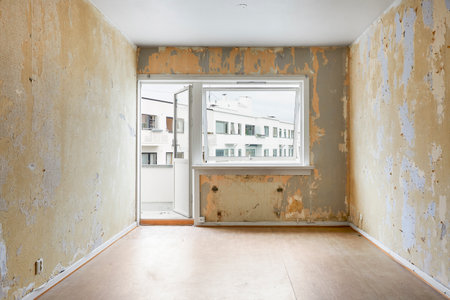Introduction to Leasehold in the UK
When navigating the world of British property, the concept of leasehold stands out as a uniquely layered aspect of home ownership. Unlike freehold, where you own both the building and the land it sits on outright, leasehold means you own the property for a set period but not the land beneath it. This arrangement has deep historical roots, dating back to feudal times when land was largely controlled by aristocracy and leased out to tenants under strict conditions. Over time, leaseholds became especially common in urban developments and apartment blocks across England and Wales, shaping how city dwellers experience their homes.
| Aspect | Leasehold | Freehold |
|---|---|---|
| Ownership Duration | Fixed term (often 99-125 years) | Indefinite/permanent |
| Ownership of Land | Land owned by freeholder/landlord | You own both land and property |
| Responsibilities | Subject to ground rent & service charges | Full responsibility for maintenance and costs |
| Common Properties | Flats/apartments, some houses | Mainly houses |
This distinction is more than technical—it directly influences your rights, responsibilities, and even your daily life at home. As we delve deeper into the leasehold system, understanding its origins and structure is essential for anyone considering buying or living in a leasehold property in the UK.
Your Rights as a Leaseholder
Understanding your rights as a leaseholder in the UK is essential for protecting your investment and ensuring you have a say in how your home is managed. Leasehold law offers several key legal rights, each designed to empower residents and promote fair management of their properties. Below, we summarise the most important legal entitlements for UK leaseholders.
Key Legal Rights Afforded to Leaseholders
Right |
Description |
Typical Requirements |
|---|---|---|
| Lease Renewal (Lease Extension) | The right to extend your lease by 90 years (for flats) or 50 years (for houses), usually at a ‘peppercorn’ ground rent. | Must have owned the property for at least 2 years; fees apply. |
| Right to Manage (RTM) | The collective right for leaseholders to take over management responsibilities from the freeholder, without having to prove mismanagement. | At least 50% of leaseholders in the building must agree; applies to qualifying buildings only. |
| Enfranchisement (Collective Purchase of Freehold) | The right for leaseholders to collectively buy the freehold of their building, gaining greater control over its management. | Majority of leaseholders must participate; certain criteria apply regarding building structure and occupancy. |
| Consultation on Major Works | Freeholders must consult leaseholders before carrying out major works or charging significant costs through service charges (‘Section 20’ consultation). | Applies if costs per leaseholder exceed £250; provides opportunity to comment or nominate contractors. |
| First Refusal on Sale of Freehold | If the freeholder wishes to sell the freehold, they must first offer it to qualifying leaseholders (the ‘right of first refusal’). | Applies to most blocks of flats with at least two-thirds let on long leases. |
The Benefits of Knowing Your Rights
A strong grasp of these rights not only provides reassurance but also opens up opportunities for improved living standards, increased property value, and greater autonomy. For instance, extending your lease can make your flat more attractive on the market, while exercising the Right to Manage enables residents to select service providers that best suit their needs and budget. Staying informed ensures you’re equipped to navigate negotiations with freeholders and proactively address issues as they arise.

3. Leaseholder Responsibilities and Obligations
Understanding your responsibilities as a leaseholder is crucial for maintaining both your property’s value and harmonious relations with freeholders or managing agents. The lease agreement you sign is a binding contract, and failing to adhere to its terms can have serious consequences—including legal action or even forfeiture of your lease. Below, we detail the most common obligations that come with leasehold ownership in the UK.
Service Charges
Service charges are regular payments made by leaseholders to cover the cost of maintaining and repairing the building’s communal areas, such as hallways, lifts, gardens, and roofs. These charges can vary from year to year depending on maintenance needs and planned works. It’s essential to review service charge accounts provided annually, ensuring transparency and accountability from the freeholder or managing agent.
Ground Rent
Ground rent is a fixed annual fee paid to the freeholder as stipulated in your lease. Traditionally, ground rents were nominal; however, some modern leases include escalating clauses, which have become controversial in recent years. Always check your lease for ground rent terms and be aware of upcoming legislative changes aimed at reforming unfair practices.
Maintenance and Upkeep
The responsibility for repairs is often split between leaseholders (for their individual flats) and the freeholder (for communal areas). As a leaseholder, you must keep your property in good repair, often including internal plumbing, electrics, and decoration. Major works affecting the whole building usually require consultation under Section 20 of the Landlord and Tenant Act 1985 if costs exceed a certain threshold.
Key Leaseholder Obligations Overview
Obligation |
Description |
Responsibility |
|---|---|---|
| Service Charges | Payments for upkeep of communal areas | Leaseholder pays; Freeholder/Managing Agent manages |
| Ground Rent | Annual rent paid to freeholder as per lease terms | Leaseholder pays; Freeholder receives |
| Internal Repairs | Maintenance of interior fixtures & fittings within flat | Leaseholder |
| Building Insurance Contribution | Payment towards insurance for entire block/building | Leaseholder pays share; Freeholder arranges policy |
| Compliance with Lease Terms | No unauthorised alterations, subletting restrictions etc. | Leaseholder must adhere strictly to all conditions set out in the lease agreement |
Compliance with Lease Terms
The lease may also restrict how you use your property—for example, prohibiting running a business from home, owning pets, or making structural alterations without consent. Non-compliance can result in enforcement action or additional fees. Always seek written permission from the freeholder before making any significant changes.
4. Common Pitfalls and How to Avoid Them
When navigating the world of leasehold in the UK, it’s essential to be aware of several common challenges that can turn your dream home into a costly headache. Below, we explore the most frequent pitfalls—such as escalating ground rents, issues with short leases, and hidden charges—alongside practical strategies for steering clear of trouble.
Escalating Ground Rents
One of the most notorious traps in modern leaseholds is the presence of ground rents that increase sharply over time. Some leases contain clauses where the ground rent doubles every 10 or 20 years, making the property difficult to sell or mortgage in future.
How to Avoid:
- Always read the lease agreement thoroughly and pay close attention to ground rent clauses.
- If possible, negotiate a peppercorn (nominal) rent or fixed ground rent terms before exchange.
- Seek legal advice from a conveyancing solicitor familiar with leaseholds.
Lease Length Pitfalls
Many buyers overlook the remaining term of their lease. A lease with fewer than 80 years remaining can significantly reduce your propertys value and make securing a mortgage challenging. Extending a short lease is possible but often costly as premiums rise when there are less than 80 years left.
| Lease Length Remaining | Potential Issue | Advice |
|---|---|---|
| > 90 years | No immediate concern | Monitor and plan future extension |
| 80–90 years | Extension costs start increasing | Consider extending soon |
| < 80 years | “Marriage value” added to extension premium; harder resale/mortgage | Act quickly to extend; seek professional guidance |
Unexpected Costs and Service Charges
Service charges can cover everything from communal cleaning to major repairs, but these costs are sometimes poorly communicated or escalate without warning. Some freeholders may also levy administration fees for permissions or paperwork.
How to Stay Protected:
- Request a full breakdown of recent service charge accounts and planned works before purchasing.
- Read the lease for details on how charges are calculated and what they include.
- Engage with other leaseholders; collective action can sometimes challenge unreasonable fees.
Aesthetic Considerations: Preserving Your Space’s Value
A beautifully designed home can lose its allure if leasehold complications arise. To safeguard both your investment and aesthetic vision, always factor in potential restrictions on alterations or renovations imposed by the freeholder. Understanding these limitations upfront allows you to plan your interior upgrades—whether its bespoke joinery or curated colour palettes—without unwelcome surprises down the line.
5. Navigating Lease Extensions and Freehold Purchase
Extending a lease or purchasing the freehold is a pivotal moment for many leaseholders in the UK, often affecting the long-term value and desirability of a property. Understanding these processes, and their implications within the British legal context, helps avoid costly missteps and ensures informed decision-making.
Lease Extensions: Key Steps and Considerations
The process of extending your lease is governed by the Leasehold Reform, Housing and Urban Development Act 1993. Typically, if you have owned your flat for at least two years, you have the statutory right to extend your lease by 90 years on top of the existing term, with ground rent reduced to zero. However, timing is crucial; leases falling below 80 years become significantly more expensive to extend due to ‘marriage value’ calculations, which increase costs.
Lease Extension Process Overview
| Step | Description |
|---|---|
| Eligibility Check | Confirm ownership period (at least two years) |
| Valuation | Appoint a surveyor for an accurate premium estimate |
| Serve Notice | Formally notify freeholder using a Section 42 Notice |
| Negotiation | Negotiate terms or refer to Tribunal if no agreement |
| Completion | Finalise legal paperwork and register extension with Land Registry |
Collective Enfranchisement: Buying the Freehold Together
Collective enfranchisement allows leaseholders in a block of flats to purchase the freehold jointly—a process also legislated under the Leasehold Reform Act. This option offers greater control over service charges, building management, and future lease extensions. To qualify, at least half of the flats must participate, and qualifying criteria regarding lease length and ownership apply.
Main Stages of Freehold Purchase
| Stage | Description |
|---|---|
| Forming a Group | Gather majority support from fellow leaseholders |
| Selecting Nominee Purchaser | Create a company or appoint representatives for transaction purposes |
| Valuation & Funding | Commission a professional valuation and arrange collective funds |
| Serving Initial Notice | Issue Section 13 Notice to freeholder indicating intent to purchase |
| Negotiation & Completion | Bargain terms or appeal via Tribunal; complete sale and update Land Registry records |
Pitfalls and Practical Advice for UK Leaseholders
The complexity of these procedures means seeking specialist advice is highly recommended. Both routes involve legal fees, valuation costs, potential Tribunal proceedings, and coordination among multiple parties. Delays or misunderstandings can lead to increased expense or even loss of opportunity—especially if deadlines are missed or notices are incorrectly served.
6. Leasehold Reform and Future Trends
The landscape of leasehold ownership in the UK is undergoing significant transformation, with recent reforms and future trends promising to reshape the rights and responsibilities of both leaseholders and freeholders. Awareness of these developments is crucial for anyone considering purchasing a leasehold property or currently living in one.
Recent Legislative Changes
In response to longstanding concerns about unfair practices and escalating ground rents, the UK government has introduced several key legislative changes. The Leasehold Reform (Ground Rent) Act 2022, for example, has abolished ground rents for most new residential leases, providing welcome relief to incoming leaseholders.
| Reform | Key Impact |
|---|---|
| Leasehold Reform (Ground Rent) Act 2022 | New residential leases set ground rent at zero |
| Proposed abolition of leasehold houses | All new homes to be sold as freehold where possible |
Upcoming Reforms: What’s on the Horizon?
The government has signalled its intention to make it easier and cheaper for leaseholders to extend their leases or purchase their freehold. Proposals include standardising lease extension terms to 990 years, simplifying the enfranchisement process, and capping costs associated with these transactions.
What Do These Changes Mean for Leaseholders?
- Greater Security: Longer lease terms and fairer ground rent provisions mean enhanced security for homeowners.
- Simplified Processes: Streamlined procedures reduce legal complexity and potential costs.
- Enhanced Value: Properties with longer leases and no escalating ground rent may see improved market value.
Looking Ahead: Trends Shaping the Future
The trend towards empowering leaseholders and curbing exploitative practices looks set to continue. Increased transparency, digitalisation of management processes, and further government intervention are likely on the horizon. For current and prospective leaseholders, staying informed about these changes is essential for making sound decisions and safeguarding your investment.


